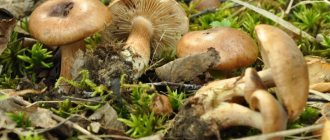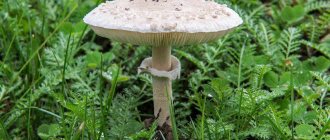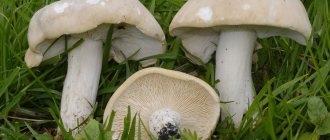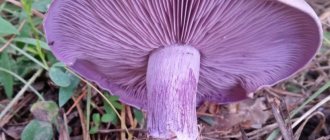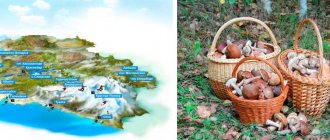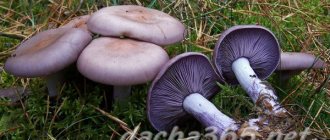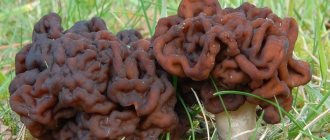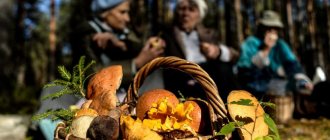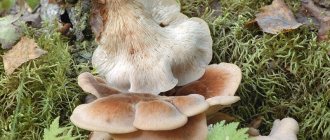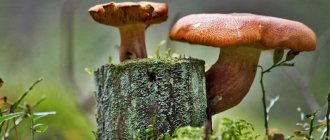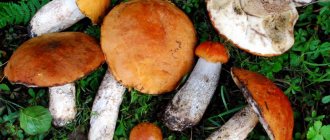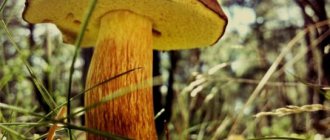Mushrooms
1
2211
Article rating
Kira Stoletova
Mushrooms from the Rowaceae family are highly valued by mushroom pickers. The gray row has an inconspicuous appearance, but it has excellent taste. Inexperienced mushroom pickers often confuse an edible mushroom with a mildly poisonous mushroom. They differ in appearance and smell.
Rowing gray edible
Pine Mouse
Gray Ryadovka - the main mushroom of late autumn
Ryadovka Gray, Tricholoma portentosum or Ryadovka Strikhovataya - an edible mushroom from the genus Ryadovka, the Ryadovkov family. It is highly valued by amateurs for its good taste and unprecedented frost resistance - this mushroom bears fruit in the fall until the hardest frosts, when there is almost nothing else to collect besides it. Gray Ryadovki, for their color and friendship with pine, are popularly called mice, serushkas and pine trees.
Edibility
It is generally accepted that the row has a weak taste, which is why it is not used for preparing gourmet dishes. But at the same time, the value of a specimen depends on the country in which it grows. Thus, in Catalonia, mice are considered one of the most common; they are often used in the preparation of classic dishes. In Europe, champignons are freely sold in stores in the same way as champignons in Russia.
On the Crimean peninsula, rowan is the most common mushroom, which is why local residents value it very much and use it everywhere in cooking. Despite the fact that it belongs to the fourth category, Crimeans prepare it by salting, boiling and frying, and add the product to salads, dumplings and pies.
In Bulgaria, the mushroom is practically not used. It is difficult to find on sale, but it can be collected in oak groves and forests, because there are almost no people willing to buy it. In Belarus it is rare and is greatly inferior to other representatives of the kingdom.
Appearance
Gray Ryadovka is the main mushroom of late autumn.
The cap is fleshy, up to 10-12 cm in diameter, in young specimens it is convex, rounded - conical, with a tucked edge, in mature specimens it is flat - spread out and uneven, with a small flat tubercle in the center, and a straightened wavy edge with cracks. The cap is colored dark gray or pale gray, often with purple tones, the center is always lighter than the edges. Dark radial fibers are clearly visible on top of it. The surface of the cap is dry and smooth to the touch; in damp weather it becomes covered with mucus, and pine needles and forest debris stick to it abundantly. In old age, the cap can become very cracked.
The hymenophore is lamellar, the plates are wide, sparsely spaced and slightly tortuous, weakly adherent. In young specimens they are white, in mature ones they are gray, with a slightly greenish-yellowish tint. Spore powder is white.
The leg is dense and smooth, longitudinally fibrous, up to 2 cm thick and 10–15 cm long, although, usually, it is half buried in the forest litter, cylindrical, with a slight thickening at the base. Initially, the leg is solid, but with age, a cavity forms inside it. The shade of the leg is from grayish-white to lemon-yellowish; on top it is sometimes covered with a fibrous-mealy coating.
The pulp is dense, white-grayish in color in the cap, and fibrous, more yellowish in the stem; at the break the yellowness is even more pronounced.
The pulp has a pleasant sweetish taste and a faint but wonderful smell of fresh flour. In older specimens, the smell becomes more rancid and unpleasant.
Description of the gray dung beetle
The gray dung beetle belongs to the genus Dungweed of the Dungweed family. Representatives of this species are often called ink mushrooms, or ink dung beetles. The definition of “inky” did not arise by chance - the cap of a ripe dung beetle transforms into an inky mass, thus spreading spores.
Young mushrooms have wrinkled, ovoid caps of grayish-white or gray color, covered with dark scales. The top of the cap is always dark. Under the cap there is a row of white plates. The leg is high, cylindrical, most often curved. Almost the entire surface is white, only the base is brownish.
As the mushroom ages, its plates gradually turn black. The cap also darkens, acquiring a brown color. By the time the spores reach maturity, the cap turns completely black. Then it loses its shape and smears with ink.
The pulp of the ink mushroom is very fragile. The initially light interior of the dung beetle rapidly darkens upon contact with oxygen. A weak but pleasant aroma emanates from the pulp. It tastes sweet. Only young mushrooms are used in cooking.
Where and When It Grows
Gray Ryadovka - the main mushroom of late autumn
Tricholoma portentosum grows in coniferous, most often pine, forests. It combines mycorrhiza with pine, which is why it is usually found next to it, hence the popular name - pine. Sometimes Ryadovka Gray can be found in mixed forests, but, again, in the vicinity of pine trees. It bears fruit on sandy soils, in mosses, under coniferous and deciduous litter. Often, on the surface of the litter, under the pine trees, only small bulges are noticeable, and in order to find the familiar gray caps, you need to carefully stir it up. The Gray Ryadovka is found in groups, or “witch circles,” or less often alone.
This is an autumn mushroom, bearing fruit from early September to late November. The best season is the end of September – the first half of October. Ryadovka Gray is widespread throughout the temperate zone of the Northern Hemisphere. In the south of Russia it can bear fruit until December, and in the central part it lasts “until the last”, until very severe frosts occur. This mushroom is famous for the fact that it easily recovers after slight frosts without losing its taste.
Description of baby mouse mushrooms and what they look like (+33 photos)?
Mouse mushrooms growing in Crimea are inferior in popularity to the well-known and widespread forest mushrooms.
However, they are highly valued among experienced mushroom pickers due to their unique taste. In different localities they are called differently: row, serushka, podzelenka, podsosnovnik. At the moment there are about two thousand representatives of this species. The colors of baby mouse mushrooms growing in Crimea may vary. They come in white, gray, purple with darker or lighter shades.
Culinary value
Gray Ryadovka - the main mushroom of late autumn
Gray Ryadovka is an excellent edible mushroom, but requires a little pre-processing - it must be soaked for 15 - 20 minutes, and then boiled for 20 minutes, after removing the skin from the cap. When cooked, the flesh of this mushroom acquires a chestnut-gray color.
After boiling, Gray Ryadovka is suitable for any culinary processing and preparation for future use. However, many lovers of mouse mushrooms do not recommend soaking them before cooking, assuring that this deprives the mushrooms of their full taste.
How to cook properly
In terms of consumption, these mushrooms are unique. They can be collected after frost: rows that thaw after frost do not lose their taste characteristics and are still edible. But still, young and fresh mushrooms are tastier, and the older the mushroom, the brighter the bitter taste is felt in its pulp.
“Little mice” do not require a special method of preparation. They are suitable for boiling, frying, salting, preparing minced meat and sauces. The only recommendation: before preparing the row, it is still better to remove the film on the cap. Boiled mushrooms darken slightly and change color: the once purple flesh becomes gray-white or chestnut. In lightly salted water, these mushrooms reach readiness within 20 minutes. But before cooking, it is important to clean and rinse them several times.
Ready-made rows have a specific aroma. Some people love it and add “mice” to dishes made from other mushrooms in order to enhance the smell. Other chefs, on the contrary, do not recommend this combination. But all this, as they say, is a matter of taste. Until you try it yourself, it is difficult to judge who is right. Boiled or fried rows go well with eggs, meat, vegetables and rice. Caviar is prepared from some varieties of these mushrooms.
Fresh rows are stored in the refrigerator for up to 3 days, frozen and salted for up to six months, dried and pickled for a year.
Recipe for pickled little mice
Boil the peeled mushrooms, skimming off the foam. Ready to transfer into jars, add spices (bay leaf, cloves, black and allspice). Pour boiling marinade made from water, vinegar, salt and sugar over the contents.
Pickling
Gray Ryadovka is the main mushroom of late autumn.
Mushrooms - mice are good in pickled form. Here is a folk recipe for properly marinating them in apple cider vinegar:
- Boil the mushrooms, but no more than 5 minutes.
- Prepare the marinade - take 100 g. homemade apple cider vinegar, 1 tbsp. spoon of salt, 2 tbsp. spoons of sugar, a few grains of mustard seeds and spices to your taste. Cook for 30 - 40 minutes and pour into sterilized jars.
- Before eating, do not wash the mushrooms and eat them with onion rings and a drop of sunflower oil.
Answers to common questions
Despite their inconspicuous appearance, little mice have gained great popularity among lovers of “silent hunting” due to their good taste and ease of preparation. In addition, their use brings only benefits to the human body.
>
- Author: Maria Sukhorukikh
Rate this article:
- 5
- 4
- 3
- 2
- 1
(0 votes, average: 0 out of 5)
Share with your friends!
The nutritional value
Ryadovka Gray has all the nutritional qualities characteristic of mushrooms of the Ryadovka family:
- Proteins – 3.1 g.
- Fats – 0.35 gr.
- Carbohydrates – 3.38 g.
- Fiber – 1.2 g.
- Fructose – 1.5 g.
- Glucose – 0.2 g.
Calorie content – 22 kcal.
These mushrooms contain phosphorus, calcium and potassium, as well as, in small proportions, manganese, copper, selenium, sodium, iron and zinc. The composition of vitamins is the entire group B, PP, A, C, D2, D7, K, betaine, choline. The rows contain 18 amino acids, with a predominance of lysine, threonine, alanine, phenylalanine, aspartic, stearic and glutamic acid. These mushrooms contain the substance trehalose, thanks to which they have their sweetish fruity taste.
Beneficial features
Gray Ryadovka is the main mushroom of late autumn.
Ryadovka contains many useful substances, including natural antibiotics clitocin and fomecin, which affect pathogenic bacteria and the formation of cancer cells. These mushrooms are known for their antiviral, anti-inflammatory, immunomodulatory, and antioxidant properties. Their regular consumption can help improve the functioning of the cardiovascular system, normalize blood pressure and stabilize blood sugar levels. Rowers can increase performance, stimulate brain activity, relieve nervous tension, help restore liver cells, the process of removing toxins and waste from the body, and normalize the gastrointestinal tract.
It is known that rowing increases the body's resistance to viral infections and inhibits the tuberculosis bacillus.
In folk medicine, rows are used to prepare an infusion, which is used to treat various skin diseases in the form of external lotions. Hot extract from ryadovka successfully reduces cholesterol levels in the blood.
A medicinal extract used in the treatment of cancer is made from row mycelium.
In cosmetology, powder from dried rows is used to create a facial lotion against acne and excess greasiness.
Benefit
Mushrooms should not be consumed by everyone, but their beneficial properties cannot be ignored. With regular but correct consumption of mushrooms, you can increase your immunity, this is especially important in the autumn-winter period. Mice also have antibacterial and antiviral properties and have an anti-inflammatory effect. This nutritional product helps normalize the functioning of the nervous system and cope with fatigue. Mushrooms improve brain function and normalize blood pressure.
Similar Species
The Ryadovkov family is incredibly diverse, and our heroine has many similar close relatives of varying degrees of edibility.
Row Gulden Tricholoma guldeniae
Ryadovka Gulden Tricholoma guldeniae
Outwardly very similar to Ryadovka Gray is a species from the same genus and family. Even experienced mushroom pickers sometimes cannot distinguish them from each other. They bear fruit in the same period and differ, first of all, in their habitats. The Gulden row grows in mixed forests on calcareous and loamy soils, loves the proximity of fir trees, and is rarely found in the pine forest next to our heroine. It is also distinguished by the grayish tones of the hymenophore plates, but such grayishness can also appear in Ryadovka Seraya.
Tricholoma guldeniae is named after the famous Norwegian mycologist, belongs to the conditionally edible mushrooms, is edible after preliminary boiling, and, according to experts, tastes no worse than Ryadovka Seroy.
Row Green Tricholoma equestre
or, popularly, Greenfinch
Row Green Tricholoma equestre
Another close relative of our heroine. It differs from it in its bright greenish-yellowish color, which persists even after boiling. It is very important that Greenfinch also grows under pine trees, and in the same period as the mouse mushroom, so they are often found in close groups under the same trees. Many happy collectors, having stumbled upon a huge joint colony of little mice and greenfinches in a pine forest, without looking, put them in communal handfuls in their basket. Greenfinch is a conditionally edible mushroom, and is also quite tasty, but requires more rigorous preliminary preparation - rinse thoroughly and boil. The greenfinch has many loyal fans, but if you treat it like a slob, you can seriously pay. There have been cases of serious poisoning with convulsions and pain.
Row Earthy – Gray Tricholoma Terreum
Row Earthy - Gray Tricholoma Terreum
Another not harmless relative of our heroine. It is very similar in color, but its cap is less fleshy and silky to the touch, and in wet weather it does not become sticky. It grows in approximately the same conditions and during the same period as Ryadovka Gray, and, most importantly, it has the same nickname among the people - “little mouse,” which makes it easier to confuse them. Tricholoma Terreum in the south of the country, in Crimea, can bear fruit even until February and is very popular there. However, it contains toxins that can lead to kidney failure and damage to muscle tissue, so it must be washed and boiled very well before use and not consumed in too large quantities.
Row pointed Tricholoma Virgatum
Ryadovka Pointed Tricholoma Virgatum
Also a close relative of Ryadovka Gray, very similar in the shade of the cap, but the tubercle in the center is sharper, and the cap itself is slightly more conical and smooth at the edges. The pulp of this mushroom does not have a distinct odor, but it has a pungent-burning taste, so it is completely unsuitable for food, although it is not poisonous.
Soap row Tricholoma Saponaceum
Soap row Tricholoma Saponaceum
It has such a funny name because of the smell of laundry soap emitted by its pulp. Its taste cannot be called particularly pleasant, but some fans salt this mushroom with horseradish and garlic, after a long preliminary boiling, during which the smell of soap only intensifies. Ryadovka Mylnaya is very similar to our heroine, it also grows in coniferous forests, but differs in the olive tones of the cap, darker plates, and, most importantly, its flesh turns very red when broken.
Gray Ryadovka - the main mushroom of late autumn
Gray Ryadovka is one of the most delicious representatives of the very diverse and many-faced mushroom family Ryadovka, and its unique frost resistance makes this gray pine mouse the main mushroom of late autumn.
Difference from false inedible mushrooms
The most important thing when collecting earrings is to distinguish edible from toxic, because a mistake can be fraught with serious consequences for a person. There are several main signs by which you can distinguish an edible gray row from a false one:
- The poisonous fruit has a pointed cap, which has a pronounced convexity in the src=»https://ogorod-bez-hlopot.ru/wp-content/uploads/2018/12/maxresdefault-17.jpg» class=»aligncenter» width ="1280″ height="720″[/img] False gray row
- False serushka is distinguished by a sharp soapy odor, noticeable when the cap of the tricholoma is broken. An edible mouse will have a pleasant smell, characteristic of all mushrooms.
- Edible earrings are usually located in groups, while twins are found singly.
The pulp and plates of the non-toxic mushroom will have a yellowish color, which will also help ensure that the choice is correct. The dangerous fruit has gray-white flesh.
